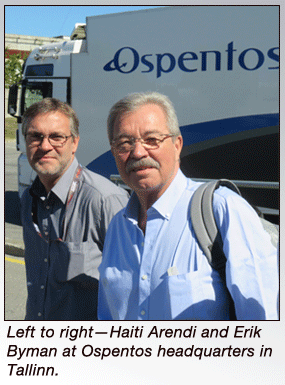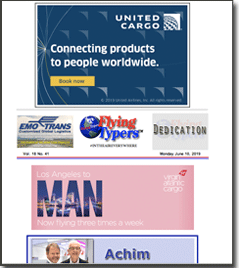|
(Forget about the fabled gorilla in the room, here SkyKing confronts
the reality of an 800-pound Amazon).
Recently Bill Boesch, the distinguished
and eloquent former President of American Airlines Cargo, explained
in a FlyingTypers column how Amazon has the capability to transform
the air cargo landscape.
Follow The Fleet
For example, the e-tailer is already “its
own air cargo customer,” thanks to its ACMI contracts with ATSG
and Atlas for Boeing aircraft, which will give it a fleet of more than
50 freighters by next year. This leaves integrators such as UPS and FedEx
in the position of both providing services to Amazon – one recent
report claimed Amazon accounts for 6.5% of total UPS revenue and 4.7%
of FedEx revenue - as well as competing with it for customers and their
cargoes.
What’s more, Amazon can easily upgrade
its air freight operations, either by buying out one of its air charter
partners or by acquiring or partnering with an integrator. “Either
move by Amazon would change the face of America’s air cargo industry
and cause withdrawal or consolidation of the present U.S. cargo charter
carriers, and maybe even one of the integrators,” argued Boesch.
He is not alone in his views. Multiple commentators
have contended that taking on the world’s leading integrators and
3PLs is a logical next step for Jeff Bezos’s brainchild.
Amazon itself claims its only aim is to
move its goods more quickly to customers and avoid delays and/or paying
premiums during peak season. However, when it filed its annual report
it listed "transportation and logistics services", previously
not identified as a rival vertical, among its list of competitors.
Shake Rattle & Roll
“Amazon is clearly shaking things
up in North America and they have built an unbelievable network and are
actually threatening FedEx’s and UPS’s core business,”
said Neel Jones Shah, SVP and Global Head of Air Freight at Flexport.
“I don’t know if that was their
intent from Day 1, but once they have built this amazing network, they
certainly don’t have to use it only for Amazon, they can use it
for third parties.”
The Price Squeeze
Already Amazon’s growing presence
in the market is putting downward pressure on prices.
“By being both vendor and carrier,
and through unprecedented data mining into customer preferences and habits,
Amazon can control its market and flatten out seasonality peaks and valleys
by adjusting prices and offering free express delivery, forcing many FedEx
and UPS customers to demand lower rates from the integrators so they can
be competitive,” added Boesch.
Amazon The Report
One recent report by Armstrong & Armstrong
- Amazon Logistics – Market Estimates, Benchmarking and Predictions
- illustrated just how significant Amazon’s logistics footprint
already is and why the demands of e-commerce are opening up opportunities
for it to emerge as an even bigger player in the logistics field.
Sorting It All Out
In the U.S., Amazon’s 38 sorting centers
comprise 11.3m square feet while its 124 logistics facilities comprise
124.7 million square feet, with another 41.1 million planned or in progress.
Amazon also has an estimated fleet of 4,000-7,500 trailers used for transport
between warehouses and fulfillment centers and is investing $1.5 billion
in its Cincinnati/Northern Kentucky Hub.
Head To Head
By comparison, UPS owns and leases more
than 1,000 package operating facilities and A&A estimated its 33 principal
facilities comprised about 17.9 million square feet.
FedEx Ground, meanwhile, has 601 total facilities,
37 of which are hubs. 373 of these facilities are co-located with FedEx
Home Delivery (B2C) operations, with an additional 38 FedEx Home Delivery
locations. “FedEx Ground hubs account for 17 million square feet.
We estimate FedEx Ground’s facilities total 46.8 million square
feet,” said the report.
Down To Brass Tacks
The report noted that Amazon’s third-party
‘marketplace’ sales already exceed Amazon’s own and
its logistics business is becoming critical to brand enhancement. “For
Amazon, logistics is inseparable from brand,” said A&A, adding
that its investments in logistics improve the customer experience, reduce
prices and feed back into its branding, therefore offering multiple reasons
why executives might see the sense of continued expansion.
The Road Ahead
Based on Amazon’s several-year $1.5
billion investment commitment at the Cincinnati/Northern Kentucky International
Airport, A&A expects Amazon to ramp up this facility and continue
to work with lessors/operators like Atlas Air to grow its fleet size for
full utilization of the hub.
“As the hub won’t be operational
until 2020 and complete until 2025–2027, we would expect any additional
build out of regional hubs to come at the tail end or after the CVG hub
completion,” added the report.
“The strategy for Amazon Air will
depend on Amazon’s international expansion. Amazon has fulfillment
centers across North America, Europe, Asia, and Australia. Third-party
sellers can ship products to either domestic or international fulfillment
centers, and Amazon will provide value-added warehousing, transportation,
and handle customs. “International sales are growing rapidly, with
80% year-over-year growth in 2016.
“Global sellers now represent a quarter
of third-party seller sales. We know international is increasing in importance
for Amazon, and the company has interest in developing e-commerce markets,
such as India.”
A&A said, in future, Amazon could establish
more regional air hubs after completion of CVG, but a more aggressive
scenario would see a strategic partnership to attack U.S. rivals.
DHL/Amazon Hook Up?
“Amazon could embark on a strategic
partnership to jointly chip away at the UPS/FedEx/USPS oligopoly,”
said the report, which suggested DHL would be a suitable partner in such
an endeavor, given that the German integrator has a hub at CVG on 181
acres, with sorting capacity of 108,000 packages per hour and 80 flights
per day. DHL also already partners with Amazon at CVG since Amazon’s
hub won’t be operational until 2020 and complete until 2027.
The Amazon Space Ship
Cathy Morrow Roberson, founder and head
analyst at Logistics Trends & Insights, told FlyingTypers
that logistics has rapidly become a competency of Amazon. “I still
believe they will take care of their customers first and if there is space
on a ship, plane, truck or van they will sell it out just like any forwarder
or 3PL would do,” she said.
What is certain is that Amazon’s next
logistics investments will have huge repercussions across the industry.
SkyKing
|


 “On June 28, 2019 when Chinese Juneyao Airlines
(HO) launches its maiden flight to Europe by opening a direct daily connection
from Shanghai Pudong International Airport to Helsinki-Vantaa Airport, we
will be ready with top handling and connection services,” Erik Byman
said.
“On June 28, 2019 when Chinese Juneyao Airlines
(HO) launches its maiden flight to Europe by opening a direct daily connection
from Shanghai Pudong International Airport to Helsinki-Vantaa Airport, we
will be ready with top handling and connection services,” Erik Byman
said.


 Vol.
18 No. 41
Vol.
18 No. 41